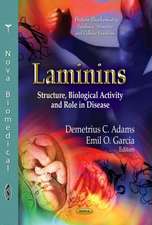A Practical Guide to Using Glycomics Databases
Editat de Kiyoko F. Aoki-Kinoshitaen Limba Engleză Hardback – 11 ian 2017
| Toate formatele și edițiile | Preț | Express |
|---|---|---|
| Paperback (1) | 790.86 lei 38-44 zile | |
| Springer – 6 iul 2018 | 790.86 lei 38-44 zile | |
| Hardback (1) | 800.75 lei 38-44 zile | |
| Springer – 11 ian 2017 | 800.75 lei 38-44 zile |
Preț: 800.75 lei
Preț vechi: 1053.62 lei
-24% Nou
Puncte Express: 1201
Preț estimativ în valută:
153.24€ • 159.40$ • 126.51£
153.24€ • 159.40$ • 126.51£
Carte tipărită la comandă
Livrare economică 09-15 aprilie
Preluare comenzi: 021 569.72.76
Specificații
ISBN-13: 9784431564522
ISBN-10: 4431564527
Pagini: 340
Ilustrații: IX, 370 p. 226 illus., 178 illus. in color.
Dimensiuni: 155 x 235 x 23 mm
Greutate: 0 kg
Ediția:1st ed. 2017
Editura: Springer
Colecția Springer
Locul publicării:Tokyo, Japan
ISBN-10: 4431564527
Pagini: 340
Ilustrații: IX, 370 p. 226 illus., 178 illus. in color.
Dimensiuni: 155 x 235 x 23 mm
Greutate: 0 kg
Ediția:1st ed. 2017
Editura: Springer
Colecția Springer
Locul publicării:Tokyo, Japan
Cuprins
Preface.- Part I Introduction.- Chapter1 Introduction.- Chapter2 Development of Carbohydrate Nomenclature and Representation.- Part II Monosaccharide and glycan structures.- Chapter 3 Translation and validation of carbohydrate residue names with MonosaccharideDB routines.- Chapter4 Using GlyTouCan version 1.0: The first international glycan structure repository.- Chapter5 CARBOHYDRATE STRUCTURE DATABASE (CSDB) – examples of usage.- Part III Glyco-related genes and proteins.- Chapter6 The CAZy Database / The Carbohydrate-Active Enzyme (CAZy) database: principles and usage guidelines.- Chapter7 Glyco3D: A Suite of Inter-linked Databases of 3D Structures of Complex Carbohydrates, Lectins, Antibodies and Glycosyltransferases.- Chapter8 GlycoGene Database (GGDB) on the Semantic Web.- Chapter9 KEGG GLYCAN Database.- Part IV Glycoproteomics data.- Chapter10 Exploring the UniCarbKB Database.- Chapter11 GlycoProtDB –A database of glycoproteins mapped with actual glycosylation sites identified by mass spectrometry.- Part V Glycan interactions.- Chapter12 GlycoEpitope.- Chapter13 SugarBindDB.- Chapter14 PAConto - RDF representation of PACDB data and Ontology of Infectious Diseases known to be related to Glycan Binding.- Part VI Glycan data analysis.- Chapter15 RINGS: a web resource of tools for analyzing glycomics data.- Chapter16 Glycan data retrieval and analysis using GLYCOSCIENCES.de applications.- Chapter17 Glycobiology meets the Semantic Web.
Notă biografică
Kiyoko F. Aoki-Kinoshita
Associate Professor, Department of Bioinformatics, Faculty of Engineering, Soka University, 1–236 Tangi-machi, Hachioji, Tokyo, 192–8577 Japan
Associate Professor, Department of Bioinformatics, Faculty of Engineering, Soka University, 1–236 Tangi-machi, Hachioji, Tokyo, 192–8577 Japan
Textul de pe ultima copertă
This book provides glycoscientists with a handbook of useful databases that can be applied to glycoscience research. Although many databases are now publicly available, one of the hurdles for their users is the learning curve required to effectively utilize those databases. Therefore, this book not only describes the existing databases, but also provides tips on how to obtain the target data. That is, because many databases provide a variety of data that could be obtained from different perspectives, each chapter provides users with potential biological questions that can be answered by a particular database and step-by-step instructions, with figures, on how to obtain that data. Troubleshooting tips are also provided to aid users encountering problems that can be predicted when using these databases. Moreover, contact information for each database is provided in case unexpected issues arise.
Caracteristici
Gives step-by-step instructions on how to use each database to obtain a particular objective, helping readers to quickly learn to use the relevant database for their research
Is written by the developers themselves, describing in detail the features that are unique to each database
Presents troubleshooting tips to explain issues that may commonly be faced by users
Is written by the developers themselves, describing in detail the features that are unique to each database
Presents troubleshooting tips to explain issues that may commonly be faced by users













